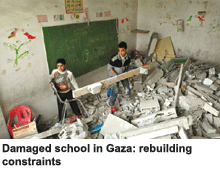Thousands of Palestinian refugee children in the Gaza Strip are unable to receive adequate education, according to the UN agency for refugees (UNRWA). About 39,000 child refugees in Gaza will not attend UNRWA schools this year, since the agency is unable to build or re-build schools due to the Israeli blockade, damage sustained during the 23-day Israeli offensive (December 27, 2008-January 18, 2009) and population growth, says UNRWA spokesperson Chris Gunness.
“My sons have trouble learning due to the large number of children, usually over 40 per class,” says Noa Ashi. Her sons Tareq (9) and Mohammed (7) attend the New Gaza Elementary School (A) run by UNRWA in Gaza City. “The classrooms are small and three children share each desk,” she says, adding that Tareq and Mohammed attend school only four hours a day.
 Israel imposed an economic embargo on the Gaza Strip after a Hamas takeover in June 2007 and in retaliation for firing of rockets from Gaza into Israel. Israel regards Hamas a terrorist organisation and says its import restrictions on items such as cement, steel and most building materials are to prevent Hamas developing weapons and fortifications.
Israel imposed an economic embargo on the Gaza Strip after a Hamas takeover in June 2007 and in retaliation for firing of rockets from Gaza into Israel. Israel regards Hamas a terrorist organisation and says its import restrictions on items such as cement, steel and most building materials are to prevent Hamas developing weapons and fortifications.
Israel says there is no humanitarian crisis in Gaza and most of the basic needs of the local population are met as at least 140 truck-loads of aid are allowed into the strip every day, which according to the UN is far from sufficient. The Israeli blockade affects every aspect of human existence and remains the biggest challenge to UNRWA in Gaza, says John Ging, director of UNRWA operations in Gaza. The blockade has destroyed the economy, making 80 percent of the population dependent on UN handouts, he adds.
UNRWA schools run double shifts in Gaza due to overcrowding. “We are also unable to recruit new teachers due to budget constraints,” says Gunness.
“There are too many students in our school and we lack the materials to build rooms,” explains Sufian Ghanem, a mathematics teacher from Jabaliyah Elementary School for Girls (B) in Gaza City. “The children are impoverished, often lacking shoes. The school lacks a library and place for outdoor activities,” adds Ghanem.
About 60,000 structures were damaged or destroyed during the Israeli offensive, according to Gunness, who says an improved infrastructure and education system in Gaza is dependent upon Israel lifting the blockade and opening the Karni crossing.
Karni, the only major commercial crossing along the Gaza-Israel border, is controlled by Israel and mostly closed, according to the UN Office for the Coordination of Humanitarian Affairs. The Gaza government aims to re-build, but has been unable to import necessary construction material, says Ahmed Yousef of the Hamas-led government in Gaza. Eighteen months after the offensive, three quarters of the resulting damage remains unrepaired.
According to Ging, there are 750,000 children in Gaza. “On this road and under these conditions — lack of access, physical deterioration and its psychological effect — the situation will get worse,” says Ging. More than half of UNRWA’s budget goes on education, with over 20,000 teachers educating half a million Palestinian children in the Levant countries each day; and 222,000 Gaza children are enroled in UNRWA schools. UNRWA also provides healthcare and other services to about one million refugees in Gaza, 800,000 of whom receive food assistance.
(Excerpted and adapted from www.irinnews.org)